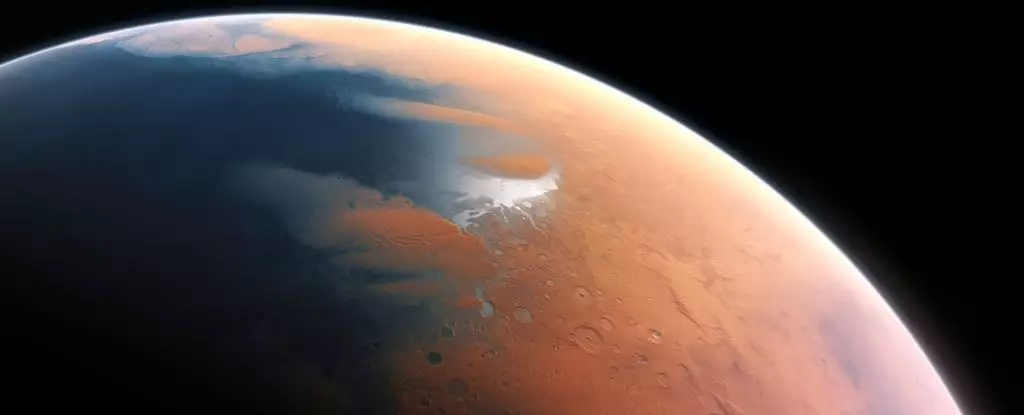As we gaze up at the night sky, Mars, the once-proud celestial neighbor of Earth, captivates our imagination with its rusty hue and barren landscapes. However, emerging evidence is suggesting that beneath its lifeless exterior lies a hidden secret: a substantial reserve of liquid water locked deep within its crust. This revelation could potentially transform our understanding of the Red Planet, which has long been a source of fascination and speculation among scientists and the public alike.
Mars is not merely a dusty, dead desert; it bears the scars of its once-vibrant surface, where ancient rivers flowed and vast lakes shimmered during its formative years. The Noachian and Hesperian epochs, spanning from approximately 4.1 billion to 3 billion years ago, were characterized by geological phenomena that indicate the planet was once teeming with hydroactivity. However, a greater mystery looms regarding the fate of this water as Mars transitioned from a warm haven for potential life to the cold, dry world we see today.
Seismic Revelations from InSight
NASA’s InSight mission, designed to probe the very depths of Mars, has provided a wealth of seismic data that hints at the presence of a hidden aquifer. By analyzing how seismic waves, particularly shear waves, traverse the Martian crust, researchers have identified a tantalizing anomaly: a layer between 5.4 and 8 kilometers deep where these waves slow down significantly. This phenomenon strongly suggests that the layer is saturated with liquid water, akin to a sponge brimming with moisture.
Utilizing data from notable seismic events, including two meteorite impacts and a marsquake, scientists were able to detect these low-velocity zones with astonishing clarity. By drawing parallels to Earth’s aquifers, they propose that this subterranean reservoir could contain enough water to envelop the entire planet in a global ocean purportedly ranging from 520 to 780 meters deep. Such a significant finding resonates with calculations regarding the “missing” water on Mars, further fueling excitement about the implications of this discovery.
A Closer Look at Mars’ Water History
The evolution of Mars’ surface has been shaped by various geological and environmental factors. The planet’s magnetic field deteriorated, leading to a thinning atmosphere that ultimately allowed most of the surface water to escape into space or freeze in its polar caps. However, residual water has been trapped in mineral formations, and the newly discovered water-bearing layer raises questions about the remaining amounts that science has yet to uncover.
The idea that water may have permeated into the Martian crust through fractures formed by meteorite impacts during the Noachian period adds a layer of intrigue to the narrative. It paints a picture of a planet that has undergone significant transformation but still harbors vital clues to its past. Beneath the surface, liquid water exists in conditions that would keep it from freezing, presenting a promising environment potentially capable of sustaining life.
The Science of Martian Seismology
InSight’s cutting-edge seismometer has played a pivotal role in mapping the Martian interior and identifying hidden features. High-frequency vibrations from seismic activity mimic the ripples created by a stone tossed into water, allowing scientists to discern the various layers of the planet’s crust through sophisticated data analysis. The identification of “receiver functions”—the signature responses of seismic waves—has revealed the intricate architecture beneath Mars’ surface, which is as complex and dynamic as its history suggests.
The implications of these findings extend far beyond academic curiosity. If reservoirs of liquid water exist as hypothesized, they may serve as critical lifelines for both microbial life and future human explorers. The potential for accessing purified water, vital for sustaining life, crafting oxygen, or even as a fuel source for missions to deeper space, positions this discovery as monumental in the context of planetary exploration.
Charting a Path for Future Exploration
While the findings from the InSight mission are groundbreaking, they are just the tip of the iceberg. The seismic data collected thus far only provides insights into a limited expanse of Mars, leaving vast areas unexplored. To truly understand the planet’s hydrological secrets, future missions equipped with advanced seismometers and analytical tools are essential.
One promising area is Utopia Planitia, which may host similar water-rich deposits awaiting discovery. This pushes the envelop of exploration beyond just scientific curiosity; it demands careful consideration of how humanity interacts with the potential of Martian ecosystems. Protecting these water-rich zones from contamination by Earthly microorganisms is critical, as they could hold the remnants of native Martian life, transforming our perspective on life’s existence beyond our planet.
As we continue to listen to the seismic “heartbeat” of Mars, we unravel layers of history, unearthing a world that may somehow mirror our own in more ways than we previously imagined. The search for water beneath the Martian surface invites us to further pursue the possibilities of life beyond Earth, igniting a lavish curiosity that continues to drive exploration and discovery across this captivating frontier.


Leave a Reply